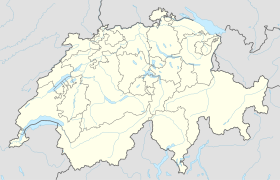Vaugondry
| Vaugondry | ||
|---|---|---|
| State : |
|
|
| Canton : |
|
|
| District : | Jura north vaudois | |
| Municipality : | Tévenon | |
| Postal code : | 1423 | |
| former BFS no. : | 5569 | |
| Coordinates : | 538 852 / 188 645 | |
| Height : | 731 m above sea level M. | |
| Area : | 0.84 km² | |
| Residents: | 35 (December 31, 2010) | |
| Population density : | 42 inhabitants per km² | |
| map | ||
|
|
||
Vaugondry was a municipality in the district of Jura-Nord vaudois in the canton of Vaud in Switzerland . On July 1, 2011, the municipality of Vaugondry merged with Romairon , Fontanezier and Villars-Burquin to form the new municipality of Tévenon .
geography
Vaugondry is 731 m above sea level. M. , seven kilometers north of the district capital Yverdon-les-Bains (beeline). The farming village extends on the southern slope of the Jura , in a panoramic position around 300 m above the lake level of Lake Neuchâtel .
The area of the former municipal area, which is just 0.8 km² in size, comprises a narrow section on the southern slope of the Chasseron chain. The area extends from the Grand Bois northwards to above the steep slope La Côte , where at 1160 m above sea level. M. the highest point of Vaugondry is reached. In 1997, 2% of the municipal area was accounted for by settlements, 45% for forests and woodlands and 53% for agriculture.
Before the merger, Vaugondry's neighboring communities were Fontaines-sur-Grandson , Villars-Burquin , Romairon and Champagne .
population
With 35 inhabitants (as of December 31, 2010), Vaugondry was one of the smallest municipalities in the canton of Vaud and Switzerland. 84.2% of the residents are French-speaking, 7.9% Portuguese-speaking and 5.3% German-speaking (as of 2000). The population of Vaugondry was 60 in 1900, but then decreased to 25 by 1980 due to strong emigration. Since then, a slight upward trend has been observed again.
economy
In Vaugondry, the livelihood structure is still characterized by agriculture today, with arable farming predominating near the village , otherwise cattle breeding . Outside the primary sector there are only a few jobs in the village. Vaugondry works closely with neighboring Villars-Burquin in terms of infrastructure .
traffic
Vaugondry is far away from the larger thoroughfares. The place can be reached by a cantonal road from Champagne and has further connections with Villars-Burquin and Romairon . The closest connection to the A5 motorway (Yverdon-Neuchâtel) is around 5 km from the town center. Vaugondry is not connected to the public transport network. The nearest bus stop on the Yverdon - Mauborget line is in Villars-Burquin.
history
The place name is probably derived from Vallis Gunderici ( Valley of the Gundric ). Vaugondry was part of the Grandson reign in the Middle Ages . After 1476 Grandson became a bailiwick under the common rule of Bern and Freiburg . After the collapse of the Ancien Régime , Vaugondry belonged to the canton of Léman from 1798 to 1803 during the Helvetic Republic, which then became part of the canton of Vaud when the mediation constitution came into force .
Attractions
In Vaugondry there are some characteristic farmhouses from the 18th and 19th centuries with a wooden gallery above the stone substructure. The place does not have its own church, it belongs to the parish of Villars-Burquin .
Web links
- Community information
- Philippe Heubi: Vaugondry. In: Historical Lexicon of Switzerland .
- Aerial photography


